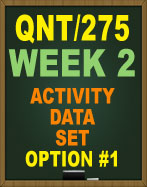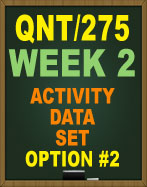QNT/275 Week 2
Individual Assignment: Business Problem
Prepare a paper
examining a business problem confronting your organization or an
organization you know of that you feel could be addressed through the
application of the business research process. Describe the problem.
Then present the research purpose and one research question
addressing an aspect of this problem. The question must contain the
variable you will measure. Discuss the measured variable. Use the
business research problem sample I2 as a guide. This paper should be
between 300-600 words. Post to the individual assignment forum. Title
the document file "Business Statistics Research Problem I2".
Note: Discussion Questions may be different, depending on which Instructor you get.
Learning Activity: Obtaining a Suitable Sample
Watch the "Obtaining a Suitable Sample" video.
Consider the following as you watch:
• Discuss the difference between convenience and random sampling.
• Explain how you can obtain a sample size representative of a population.
• Provide three examples.
• Explain why a sample is used in place of the population.
Learning Activity: Measuring Central Tendency and Variability
Watch the "Measuring Central Tendency and Variability" video.
Consider the following as you watch:
• Define the three standard measurements of the central tendency and provide example of each.
• Explain when you might want to use a median number.
• Provide an example.
• Define a standard deviation and what a standard deviation shows, provide an example.
Learning Activity: Mean, Median, and Variability
Watch the "Measuring Central Tendency and Variability" video.
Consider the following as you watch:
• Define the three standard measurements of the central tendency and provide example of each.
• Explain when you might want to use a median number.
• Provide an example.
• Define a standard deviation and what a standard deviation shows, provide an example.
Learning Activity: Mean, Median, and Mode
Watch the "Statistics Intro: Mean, Median, and Mode" video.
Consider the following as you watch:
• Explain how mean is calculated.
• Explain how a median is calculated with an even number list.
• Define an array.
• Provide an example.
• Define a mode.
• Identify if you can have more than one modal number in a set of data.
Learning Activity: Finding the Range and Mid-Range
Watch the "Finding the Range and Mid-Range" video.
Consider the following as you watch:
• Define a range and provide two examples.
• Calculate a mid-range and provide two examples
********** BONUS FILES INCLUDED **********
Collaborative Discussion: Descriptive Statistics
Read Case Study 3.3 in Ch. 3 of Essentials of Business Statistics found on page 98.
Click the Fort Myers Sales Data Set link.
Calculate descriptive statistics:the mean, median, mode, and standard deviation in the two sample periods (January
and July).
Discuss one of the following:
• Identify what changes occurred in the Fort Myers housing market during the 6-month period.
• Explain what conclusions you can draw from the data.
• Identify what additional data you might want to understand the housing market better.
• Explain what role descriptive statistics play in understanding the housing market.
Individual: Week 2 Quiz
1. In order to summarize qualitative data, a useful tool is a __________.
2. The accompanying chart shows the numbers of books written by each author in a collection of cookbooks. What type of chart is this?
3. A recent survey of 200 small firms (annual revenue less than $10 million) asked whether an increase in the minimum wage would cause the firm to decrease capital spending. Possible responses to the survey question were: "Yes," "No," or "Don't Know." These data are best classified as ____________.
4. ABC Plumbing wants to understand its customers’ perceptions of the quality of the company’s plumbing service calls. They plan to survey a sample of its customer base. What will ABC need to do to ensure that their data is valid and reliable?
5. A stem-and-leaf diagram is constructed by separating each value of a data set into two parts. What are these parts?
6. A population consists of _________________.
7. Which of the following variables is qualitative?
8. Which of the following represents a population and a sample from that population?
9. Which of the following variables is quantitative?
|














